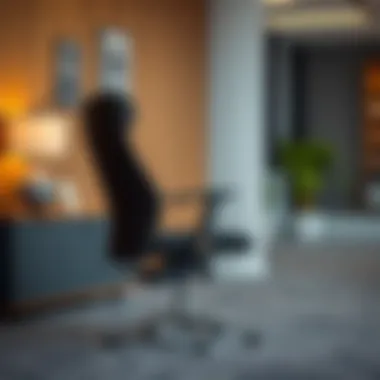The Impact of Hard Office Chairs on Productivity


Intro
In the evolving landscape of modern work environments, the choice of office seating has become more significant than ever before. While the comfort of a plush chair often tempts many, there lies a deeper importance in opting for hard office chairs. These seating solutions are not just a matter of aesthetics or personal preference; they shape our daily productivity and overall well-being in profound ways. In a society where long hours at the desk are the norm, understanding the implications of our seating choices is crucial.
Research indicates that hard office chairs can promote better posture and reduce discomfort that might come from sinking into a soft cushion.
Moreover, as individuals seek to optimize their workspaces, the significance of style and ergonomics in hard office chair design cannot be overlooked. In the upcoming sections, we will dive into the interplay between furniture design trends, practical selections, and how these choices can dramatically influence workspace effectiveness.
Furniture Design Trends
Current Trends in Furniture Design
The modern office aesthetic is continuously changing, with a noticeable shift toward clean lines and minimalistic designs that prioritize functionality. Hard office chairs fit snugly into this trend, offering a structured form that adds elegance without sacrificing comfort. Materials like molded plywood and metal are increasingly common in chair designs. These not only contribute to the visual appeal but also enhance durability, making them ideal for the rigors of daily use.
Another trend gaining traction is the integration of technology into seating solutions. For instance, chairs that contain sensors to monitor posture or adjust comfortably during use are becoming more popular. This aligns perfectly with the current emphasis on health and wellness in the workplace.
Influential Designers to Follow
If you aim to enhance your office space and are interested in hard office chairs, it's worth keeping an eye on influential designers who are pioneering innovative seating solutions. Here are a few names that stand out:
- Herman Miller: Renowned for their ergonomic chairs, they incorporate state-of-the-art design with a focus on user well-being.
- Vitra: This Swiss company is known for its unique perspective on form and has created many classic pieces that withstand the test of time while providing comfort.
- Knoll: A brand that strikes a balance between aesthetic appeal and ergonomic principles, making their office chairs an excellent choice for any workspace.
These designers are not only shaping furniture trends but also pushing the boundaries of what we consider comfortable and functional in workspaces.
Practical Tips for Furniture Selection
Choosing the Right Materials
When selecting a hard office chair, the material is pivotal. A great choice would be a chair crafted from high-quality molded plastic or wood, which can provide both support and a sturdy feel. Leather or high-performance fabric upholstery can also be beneficial, offering a touch of luxury while ensuring durability. Remember, the material chosen can significantly impact both the chair's longevity and the aesthetic vibe of your workspace.
Maximizing Space with Smart Furniture Choices
In the modern workspace, every inch counts. Choosing hard office chairs can streamline your office without overwhelming it. Here are some tips to consider:
- Height-adjustable chairs: These promote adaptability and are fit for various desk heights.
- Stackable options: Ideal for multifunctional spaces, as they allow easy storage when not in use.
- Lightweight designs: Look for chairs that are easy to move, promoting fluidity in your workspace layout.
Incorporating hard office chairs thoughtfully not only cultivates a smarter workplace but can aid in creating a health-centric environment.
"Choosing the right office chair is as crucial as selecting the right desk. It affects both comfort and productivity."
With these considerations in mind, you are well-equipped to make an informed decision that can truly elevate your workspace.
For more information about furniture design trends and practical selection tips, visit resources like Wikipedia on Office Furniture or explore engaging discussions on Reddit for personal insights from design enthusiasts.
Understanding Hard Office Chairs
Hard office chairs may seem like a mere detail in the broader scheme of workspace design, yet they hold significant importance in both functionality and aesthetics. The right chair serves beyond basic seating; it plays a pivotal role in enhancing user experience. In a world where many hours are spent sitting, the design and structure of these chairs can influence not just comfort, but also productivity and mental clarity. Understanding hard office chairs involves grasping their diverse applications, user preferences, and their transformative impact on workplace dynamics.
Definition and Purpose
A hard office chair references any chair that is characterized by a firm seat and backrest, often crafted from materials like wood, metal, or molded plastic. Unlike cushioned chairs, which can sometimes be overly plush and foster slouching, hard chairs promote a position that encourages good posture. This can ultimately reduce fatigue during long periods of work.
Purpose isn’t solely about comfort; it extends to supporting overall health. Proper seating that encourages an upright position can alleviate spinal strain, promoting better overall wellness.
In practical terms, a hard office chair is designed to be durable and easy to maintain. For instance, wood finishes can withstand wear and tear, making them a staple in corporate environments where longevity is valued. They also often align aesthetically with the decor of modern offices, whether it's a minimalist or a traditional design.
Historical Context
The evolution of office seating has seen significant changes influenced by societal needs and preferences. In the early 20th century, office chairs were primarily utilitarian, serving just the basic function of providing a place to sit. These models were generally constructed from heavy materials that bore little resemblance to contemporary models. As workplace dynamics began shifting in the 1950s, the demand for functionality started to intertwine with design. The hard office chair began to attain recognition as a symbol of professionalism.
During this era, designers like Charles and Ray Eames introduced concepts that infused artistry into functional furniture. Hard office chairs in the mid-century modern style broke away from drab designs, incorporating elegant lines and simple functionality, thereby transforming them into focal points within office decor.
Today, this historical context enriches our understanding of hard office chairs by highlighting how design philosophies evolve and adapt in pace with changing work practices and aesthetic preferences. They are not simply relics of the past; instead, they serve as an example for how functionality married to design can elevate physical environments.
Hard office chairs are more than just furniture; they signify a complex relationship between comfort, design, and function, underlining the careful considerations in modern workspace design.


In summary,
- Definition is rooted in their firm structure that influences comfort and posture.
- Purpose extends beyond comfort; it encompasses health and aesthetic contribution.
- Historical context reveals transformations that reflect broader societal shifts and evolving workplace dynamics.
Through understanding these elements, one gains a clearer perspective on selecting the right hard office chairs, ultimately uplifting both workspace aesthetics and user experience.
Design Elements of Hard Office Chairs
Design elements play a pivotal role in shaping the functionality and aesthetics of hard office chairs. The choice of materials, the structural components, and even the aesthetic variations can significantly influence users’ comfort and the overall ambiance of a workspace. When considering these elements, it is essential to explore not only their physical attributes but also their implications on user experience and productivity.
Materials Used
Wood
Wood is a classic choice for hard office chairs, often seen in traditional settings but making its way into contemporary designs too. Its primary charm lies in its sturdiness. A well-crafted wooden chair offers a natural elegance that elevates any office decor. Wood, particularly from sustainable sources, adds an element of warmth to the often sterile look of modern workplaces. On the downside, wooden chairs can be hefty, which may limit their mobility and ease of relocation around a work environment. Furthermore, if not treated properly, wood can be susceptible to scratches and wear over time.
Metal
When talking about metal in hard office chairs, strength and durability come to mind right away. Metal chairs are typically lightweight yet sturdy, making them versatile for various office configurations. Steel frames, in particular, provide superior support and can withstand heavy usage without compromising structural integrity. However, some might find metal chairs to be less comfortable without added cushioning, and they may not fit well with more cozy or traditional settings.
Plastic
Plastic is often overlooked, but it offers a unique set of advantages. Its lightweight nature makes plastic chairs extremely portable, which is perfect for dynamic workspaces where furniture needs to be rearranged frequently. Additionally, these chairs can come in a variety of colors and designs, allowing for greater customization in aesthetic appeal. However, plastic may not convey the same level of sophistication as wood or metal, and over time, it could become less durable, particularly under regular exposure to sunlight.
Structural Components
Seat
The seat of a chair is arguably its most critical component. It provides the first point of contact between the user and the chair. A well-designed seat incorporates aspects such as thickness, cushioning, and material. Chairs with ergonomic seat designs facilitate proper posture, which is beneficial for long hours of sitting. A poor-quality seat, however, can lead to discomfort and distractions, thereby affecting productivity.
Backrest
A strong backrest is essential for lumbar support, which helps maintain the natural curve of the spine. Chairs that offer adjustable backrests can be tailored to fit individual needs, promoting better posture. Additionally, a high-quality backrest can significantly reduce strain during prolonged periods of sitting. On the other hand, a rigid or poorly designed backrest could end up being painful, creating a negative seating experience.
Armrests
Armrests are often underestimated components of hard office chairs. They provide essential support to the arms, helping to reduce shoulder and neck strain. A well-positioned armrest can improve overall comfort, allowing the user to focus more on their tasks without constant discomfort. Nevertheless, if armrests are too high or wide, they can become a hindrance, limiting movement and causing frustration.
Aesthetic Variations
Minimalist Designs
Minimalist designs in hard office chairs often emphasize simplicity and functionality. These designs eliminate excess to focus on utility, making them a favorite for modern offices that value clean lines and open spaces. Their understated elegance often complements various interior styles. However, the lack of embellishment may not suit every personal taste or company culture.
Traditional Styles
Traditional styles evoke a sense of comfort and familiarity. Often made from rich woods and featuring classic upholstery, these chairs conjure images of dignified boardrooms or refined home offices. They can truly ground a space in history. Conversely, they may seem out of place in ultra-modern settings where sleek designs are favored.
Contemporary Looks
Contemporary looks aim to blend bold designs with functionality. These chairs often feature striking shapes and innovative materials. A contemporary chair can serve as a focal point in a workspace, adding a dash of creativity to otherwise mundane office environments. Yet, they may not always be the best choice for those prioritizing traditional comfort.
Ultimately, the design elements of hard office chairs enhance user experience and overall productivity. By understanding the materials used, structural components, and aesthetic variations, individuals can make informed decisions that align both functionality and style in their workspaces.
Ergonomics and User Comfort
In modern workplaces, the fusion of ergonomics and user comfort is a cornerstone of effective design, particularly in the selection of hard office chairs. These chairs serve not only as seats but as essential tools that can significantly influence well-being and productivity. Choosing the right office chair can mitigate common workplace ailments and optimize comfort, ultimately translating to a more engaged workforce.
Understanding Ergonomic Principles
The essence of ergonomics lies in understanding how humans and elements of their environment interact. Ergonomic principles take into account human anatomy, physiology, and psychology to enhance comfort during prolonged use—like sitting at a desk for hours on end. Hard office chairs, designed with these principles, provide a stable structure that supports natural body posture.
- Adjustability: Many ergonomic chairs come equipped with features that allow users to adjust the height of seats, the tilt of the backrest, and even the armrest positioning. This adaptability caters to the diverse statures and preferences of different users.
- Lumbar Support: One of the most pivotal aspects is the lumbar support, which helps maintain the natural curve of the spine. A well-designed chair with good lumbar support alleviates strain on the lower back, promoting healthier sitting posture.
A chair designed with ergonomics in mind will encourage appropriate posture, reducing muscle fatigue and enhancing circulation. Without such considerations, the risk of discomfort or injury is far greater.


Benefits of Proper Support
Investing in a hard office chair that offers proper ergonomic support yields multiple benefits:
- Enhanced Comfort: Proper support alleviates pressure points, making it easier to remain seated for extended periods. This increased comfort can lead employees to focus more intently on their tasks rather than fidgeting in their seats.
- Improved Posture: Good support ensures that the spine aligns correctly. This habit can help avoid common postural problems that could arise from habitually slumping in the wrong chair.
- Increased Productivity: Comfortable employees are productive employees. By experiencing less physical strain, workers can devote more mental energy to their work, enhancing output.
As these points emphasize, a hard office chair with ergonomic features can make a significant difference in an employee's experience at work.
Potential Risks of Poor Seating
Failing to prioritize ergonomics when selecting office seating can lead to several adverse outcomes:
- Musculoskeletal Disorders: When sitting in poorly designed chairs, individuals may develop conditions such as chronic neck pain, lower back pain, and shoulder tension. These disorders often stem from inadequate back support leading to misalignment and undue strain.
- Decreased Productivity: Constant discomfort can become a distraction, making it difficult to concentrate on work. This can slow down progress and decrease overall workplace efficiency.
- Long-term Health Issues: Over time, inadequate seating arrangements may contribute to serious health problems, including joint injuries and even cardiovascular issues due to prolonged inactivity.
"Proper seating is not just about comfort. It’s about fostering a healthier work environment that can sustain productivity over the long haul."
In summary, the relationship between ergonomics and user comfort cannot be overstated in the context of hard office chairs. By understanding these elements, individuals and businesses alike can make informed decisions that contribute to overall health and productivity.
Impact on Productivity
The relationship between the furniture we use and our productivity cannot be overstated. Within the realm of workspace design, hard office chairs play an integral role in shaping employees' daily experiences. Not only do they influence comfort levels, but they also impact overall focus and efficiency. When one spends several hours sitting, it is crucial that the chair serves more than just a functional need; it has the potential to either bolster performance or hinder it.
Connection Between Comfort and Focus
Comfort is the foundation that underpins concentration. Various studies reveal that when individuals are comfortable, they tend to focus better. Hard office chairs provide a stability that can often be overlooked. Unlike soft cushioned seats that may cradle one too leisurely, hard chairs encourage an active seating posture.
Research indicates that people seated on hard surfaces are more likely to adjust their positions, which enhances blood circulation and keeps the mind alert. A chair that offers firm support for the back can reduce distractions associated with stiffness or discomfort. It’s not merely about how soft or plush a chair feels; it’s about how it makes the user feel. The word "uncomfortable" can seep into one’s thoughts when the body is in distress, which is why hard office chairs—through their structured design—can actively contribute to better focus.
"The right seat makes a world of difference in the office environment; it can transform a daily grind into a productive routine."
Workplace Efficiency
One of the most telling signs of an effective workspace is the seamless flow of work. Hard office chairs can maximize efficiency in several ways. First and foremost, the design often encourages a good posture. This support minimizes physical strain, leading to fewer breaks due to discomfort. Workers may find themselves engaging in their tasks for longer periods without the interruption of needing to stand or stretch.
Moreover, hard office chairs often have a minimalist aesthetic. This simplicity can reduce visual clutter, which fosters a sense of calm. In spaces where distractions abound, the mere presence of a thoughtfully designed chair can anchor attention, keeping eyes on tasks rather than wandering to nearby trinkets or distractions.
In addition, these chairs often incorporate adjustable features that allow users to customize their seating experience, catering to personal preferences without sacrificing support. This flexibility can further enhance efficiency, as employees feel empowered in their work environment.
Choosing the Right Hard Office Chair
Selecting an appropriate hard office chair is not just a matter of aesthetics; it significantly influences one’s comfort and productivity in modern workspaces. A thoughtful choice can resonate through all aspects of work life, promoting a healthier posture and enhancing overall work efficiency. Hence, understanding the nuances of what makes a chair suitable is essential for anyone looking to invest in their comfort and wellbeing as they work.
Assessing Personal Needs
Before diving into the sea of choices available in the market, it's imperative to first evaluate your own specific needs. This involves reflecting on factors such as:
- Body Type: Different chairs offer different support levels. A chair that works well for a tall person might not provide the same support for someone shorter.
- Work Habits: Do you spend hours at your desk, or just a few minutes at a time? For those engaged in prolonged sitting, extra lumbar support becomes crucial. If you’re occasionally up and about, a less restrictive design might be adequate.
- Health Considerations: People with existing back pain or similar issues should seek chairs with adjustable features, allowing customization that accommodates their health requirements. The right fit can mean the difference between a tiring day and a productive one.
Identifying these personal elements not only helps in honing in on a suitable chair but also increases the likelihood of making an informed choice that aligns with one’s lifestyle and comfort level.
Testing for Comfort
Once potential candidates are identified, it’s time to put them to the test. Comfort shouldn’t be a hasty decision; it needs to be earned through actual usage. Here are practical ways to ensure you find the right fit:
- Sit and Adjust: When testing, sit for at least 10 to 15 minutes. Adjust the height, backrest angle, and armrest positions to see what feels best.
- Check Mobility: Ensure that you can easily swivel, roll around, and shift in your chair without feeling cramped or restricted. Good mobility can prevent strain and enhance comfort during longer work hours.
- Revisit After Movement: Stand up and then sit back down. Notice whether the chair feels different after time away from it. Space can shift your perception of comfort, so give it a fair shot.
By testing potential chairs thoroughly, you gain a tactile understanding of what works best for your body. Comfort that feels right can often sway your final decision significantly.
Price vs. Quality
As with most things in life, you often get what you pay for, especially when it comes to office furniture. Balancing price and quality is a fundamental consideration:
- Investment in Health: Higher quality chairs may come with a steeper price tag. However, investing in a well-constructed chair can save you from potential health issues down the road, ultimately being more cost-effective in the long run.
- Durability vs. Aesthetics: While you might find cheaper alternatives, they might not hold up over time. A chair that needs replacement every few years can add up in cost, whereas a quality chair can last a decade or more.
- Warranty and Support: Opt for brands that offer warranties. This not only indicates the manufacturer's confidence in their product but also assures you of support in case of defects or issues.
In the end, opting for quality—while not neglecting comfort—can often yield better results than simply choosing the cheapest option.


Choosing the right hard office chair is a significant decision that can lead to increased comfort and productivity. By assessing personal needs, rigorously testing comfort, and weighing the balance between price and quality, anyone can navigate through choices and find the perfect fit for their workspace.
"Investing in a hard office chair is investing in your health and productivity."
As you make your selection, remember that an informed choice today will lay the foundation for your work environment’s effectiveness tomorrow. For more resources on effective office ergonomics, check out American Chiropractic Association or the Occupational Safety and Health Administration.
Maintenance and Care
Taking care of hard office chairs goes beyond just aesthetics; it plays a significant role in ensuring longevity and comfort. A chair that’s well-maintained not only looks good but also supports your body better, contributing to overall productivity in the workplace. Just as a well-oiled machine performs better, a clean and cared-for chair aids in your daily efficiency. Here, we will delve into important guidelines for cleaning and considerations regarding the longevity of your hard office chairs.
Cleaning Guidelines
Cleaning hard office chairs is not just about removing visible dirt. Regular maintenance preserves the materials and enhances the comfort level, which is crucial for long hours of use. Here’s a breakdown of effective cleaning practices:
- Dust Regularly: Using a soft cloth, dust the chair weekly to remove particles that could scratch or damage the finish.
- Spot Clean Stains: If there are spills or stains, address them promptly. Use a damp cloth with gentle soap to avoid damaging the surface.
- Use Appropriate Cleaners: Depending on the material, use specific cleaners. For leather chairs, mild soap and a damp cloth work well; for plastic, a basic all-purpose cleaner is sufficient. Always test in a less visible area first.
- Avoid Harsh Chemicals: Steer clear of abrasive cleaners or any that might contain bleach. Such substances may cause more harm than good.
Cleaning is an investment in your furniture. A simple wipe down can prolong the life of your chair and maintain its appearance.
Scheduled maintenance also includes checking parts like screws and fittings to ensure everything is intact, which reduces wear and tear over time.
Longevity Considerations
Taking care of hard office chairs contributes to their lifespan. Here are some aspects to consider when maintaining them:
- Material Selection: Choosing chairs made of durable materials can significantly affect longevity. Wood and metal, for example, tend to outlast plastic counterparts.
- Proper Usage: Avoid excessive weight or misuse, such as leaning back too far, which can compromise productivity by damaging the chair.
- Rotate Usage: If multiple chairs are present, rotating their use can help distribute wear more evenly.
- Adjustments and Repairs: Make sure to regularly check if the chair’s adjustments still meet your needs. If any mechanism is faulty, repair it immediately rather than letting it slide.
- Storage Considerations: If not in use, store chairs in a dry area, away from extreme temperatures and direct sunlight, which can degrade materials.
Addressing these maintenance aspects enhances a chair's benefits over time, leading to a more pleasant sitting experience. Therefore, adopting a mindful approach to chair maintenance not only protects your investment but also promotes health and productivity in the workspace.
For more on furniture maintenance tips, resources like Wikipedia's Home Maintenance or Britannica's Furniture Care can provide additional insights.
Future Trends in Office Seating
In the arena of workplace design, office seating is undergoing a transformation that influences not only aesthetics but also health and productivity. As businesses begin to prioritize employee well-being and comfort, the significance of future trends in office seating cannot be overlooked. The development of hard office chairs is particularly noteworthy, as they are now evolving to meet the demands of a modern workforce that values both function and style.
Innovative Materials
The materials that make up hard office chairs are no longer limited to traditional wood or metal. Today, designers are conceptualizing seating made from an array of innovative materials. For instance, biodegradable plastics and recycled composites are gaining traction in the market. This shift not only benefits the environment but also appeals to a growing demographic that prioritizes sustainability in their buying choices. Some key innovative materials include:
- Eco-friendly fabrics: Fabrics made from regenerated fibers can offer durability while reducing the carbon footprint.
- Carbon fiber: Lightweight yet incredibly strong, carbon fiber chairs are making waves by combining elegance with resilience.
- Smart materials: These can shift their properties based on changes in temperature or pressure, offering customized comfort that responds to the user.
These materials not only improve functionality but also contribute to a visually stimulating workspace, allowing designers to think outside the box.
Technological Advancements
In tandem with materials, technological advancements are revolutionizing how hard office chairs function. Integrating technology into the design can enhance the user experience significantly. For example, chairs equipped with sensors to monitor posture and provide real-time feedback will soon become commonplace. This innovation can help employees avoid common issues like back pain and poor posture over long working hours. Additionally, other technological enhancements include:
- Heating and cooling systems: With the click of a button, chairs can adjust temperatures to ensure comfort throughout the day.
- Smart connectivity: Workstations that allow chairs to communicate with desks and screens for an optimized work setup.
- Adjustable components: Innovations in mechanism design now allow for seat height, armrest, and backrest adjustments to be made swiftly and without cumbersome dials or levers.
The seamless incorporation of tech in office seating reflects a moving tide toward a more integrated workspace experience, marrying comfort with functionality.
"The future will bring chairs that not only seat but also sense and support, a smart pairing of ergonomics and innovation."
As interior designers and businesses delve into these advancements, understanding the potential of future office seating trends can help shape more conducive work environments that foster creativity and enhance productivity. The investment in hard office chairs equipped with innovative materials and technology will not just be a trend; it will be a step toward reimagining what office comfort truly means.
Closure
In reflecting on the importance of hard office chairs within contemporary workspaces, it becomes evident that these pieces of furniture extend far beyond mere utility. They represent a convergence of health, productivity, and aesthetic appeal, signaling to employers and employees alike that the workspace enhances both function and style. Understanding the various elements that contribute to their significance lays the foundation for making more informed decisions.
Summarizing Key Points
A few key takeaways emerge from our exploration:
- Functionality: Hard office chairs provide necessary support, helping to maintain proper posture during long hours of work. This support not only helps in reducing discomfort but encourages increased focus.
- Material Matters: The selection of materials, be it sturdy wood, resilient metal, or adaptable plastic, influences both the durability and the overall comfort level of the chair. A well-constructed chair can last for years, making it a worthy investment.
- Aesthetic Appeal: With various designs available, from minimalist to traditional, hard office chairs can seamlessly integrate into any workspace theme, enhancing the overall decor.
- Impact on Productivity: A comfortable seating arrangement is closely tied to employee productivity. When individuals are at ease physically, they are more likely to excel mentally.
By summing up these vital points, we see that hard office chairs serve a purpose that extends beyond just supporting the body. They play a crucial role in fostering an environment where creativity and efficiency thrive.
Final Thoughts on Hard Office Chairs
As we navigate the evolving landscape of work environments, the significance of hard office chairs cannot be overlooked. These chairs embody comfort and stability while enhancing workplace aesthetics, leading to a more productive atmosphere. The conscientious selection of a chair impacts not just one's immediate comfort, but also longer-term health outcomes, encouraging a more straightforward, practical choice.
When considering a hard office chair, take time to assess personal needs. Testing out various models before making a commitment can lead to a much-enhanced experience. Engaging with brands known for their ergonomic designs and quality materials, like Herman Miller or Steelcase, can further ensure long-term satisfaction.



